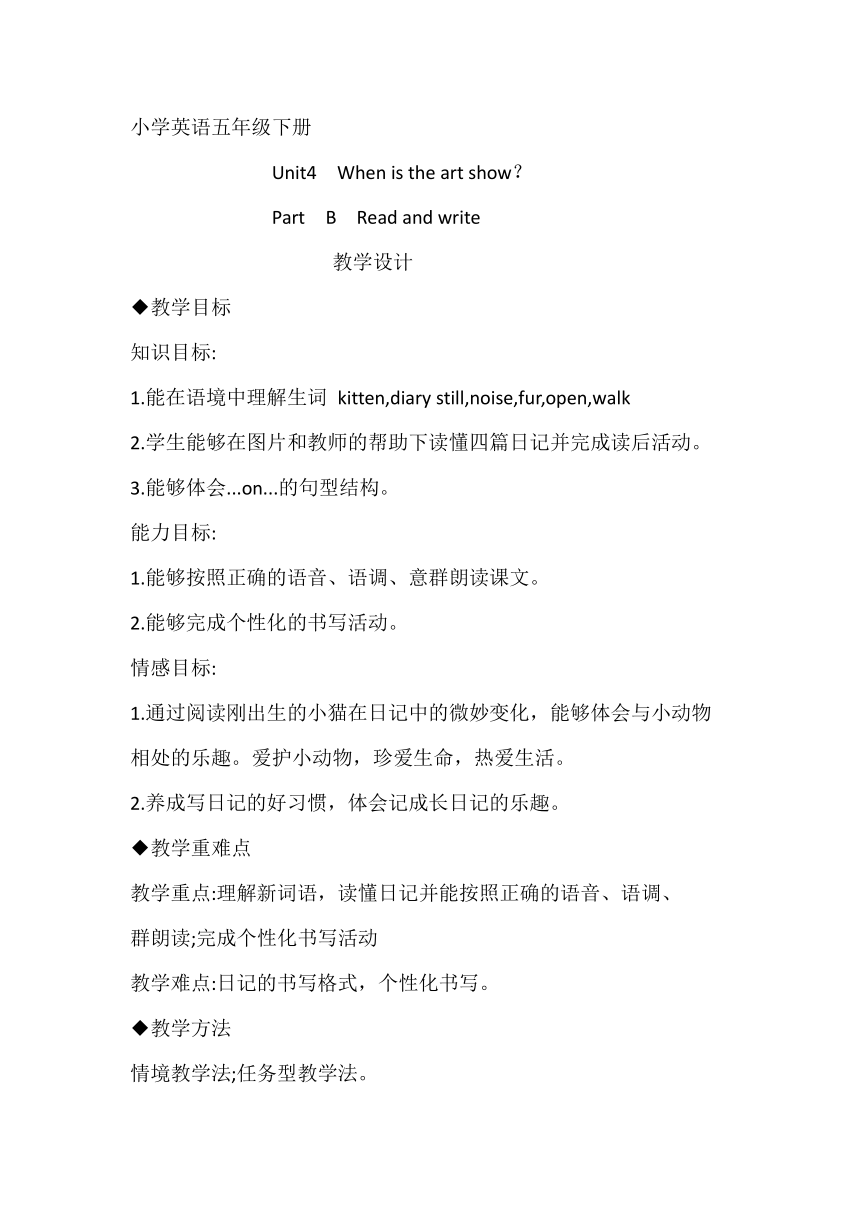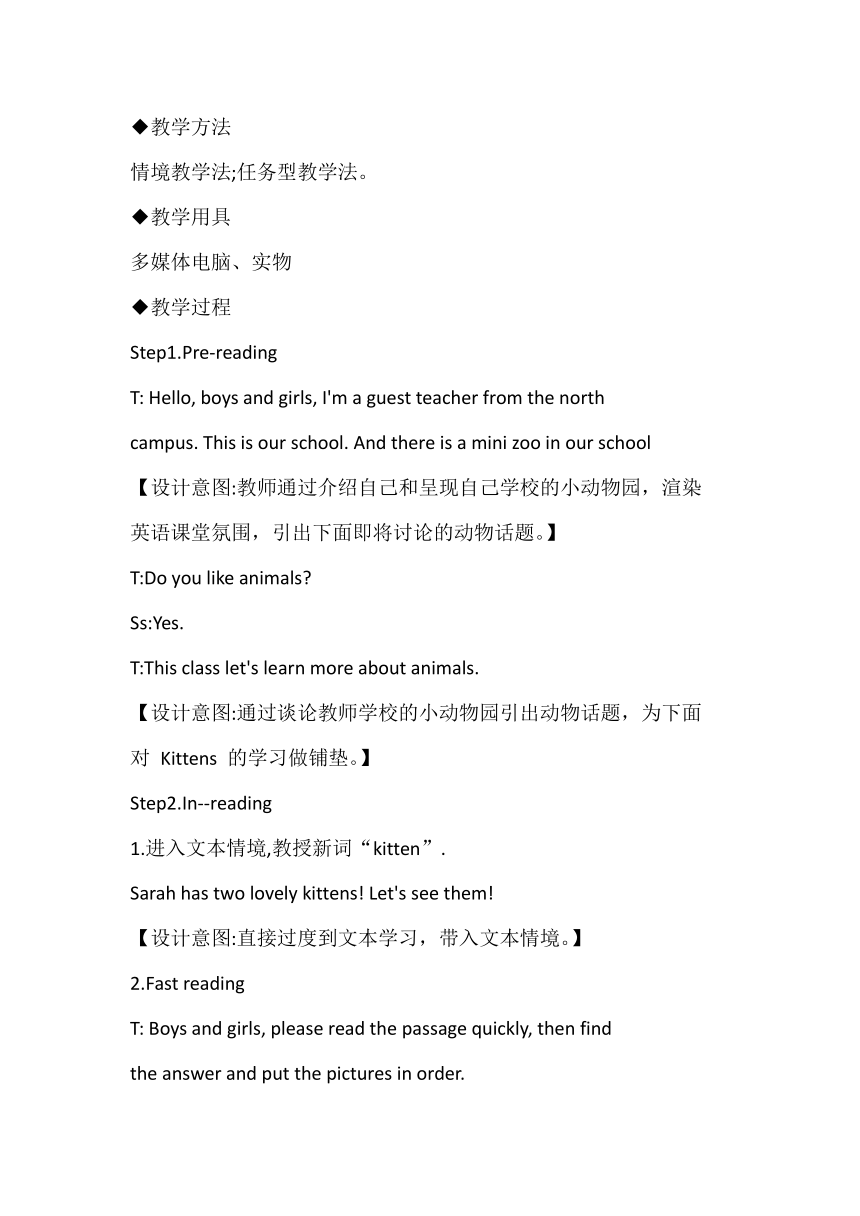Unit 4 When is the art show? Part B Read and write 教案
文档属性
| 名称 | Unit 4 When is the art show? Part B Read and write 教案 |

|
|
| 格式 | docx | ||
| 文件大小 | 14.1KB | ||
| 资源类型 | 教案 | ||
| 版本资源 | 人教版(PEP) | ||
| 科目 | 英语 | ||
| 更新时间 | 2024-02-24 21:30:09 | ||
图片预览



文档简介
小学英语五年级下册
Unit4 When is the art show?
Part B Read and write
教学设计
◆教学目标
知识目标:
1.能在语境中理解生词 kitten,diary still,noise,fur,open,walk
2.学生能够在图片和教师的帮助下读懂四篇日记并完成读后活动。
3.能够体会...on...的句型结构。
能力目标:
1.能够按照正确的语音、语调、意群朗读课文。
2.能够完成个性化的书写活动。
情感目标:
1.通过阅读刚出生的小猫在日记中的微妙变化,能够体会与小动物
相处的乐趣。爱护小动物,珍爱生命,热爱生活。
2.养成写日记的好习惯,体会记成长日记的乐趣。
◆教学重难点
教学重点:理解新词语,读懂日记并能按照正确的语音、语调、
群朗读;完成个性化书写活动
教学难点:日记的书写格式,个性化书写。
◆教学方法
情境教学法;任务型教学法。
◆教学方法
情境教学法;任务型教学法。
◆教学用具
多媒体电脑、实物
◆教学过程
Step1.Pre-reading
T: Hello, boys and girls, I'm a guest teacher from the north
campus. This is our school. And there is a mini zoo in our school
【设计意图:教师通过介绍自己和呈现自己学校的小动物园,渲染
英语课堂氛围,引出下面即将讨论的动物话题。】
T:Do you like animals
Ss:Yes.
T:This class let's learn more about animals.
【设计意图:通过谈论教师学校的小动物园引出动物话题,为下面
对 Kittens 的学习做铺垫。】
Step2.In--reading
1.进入文本情境,教授新词“kitten”.
Sarah has two lovely kittens! Let's see them!
【设计意图:直接过度到文本学习,带入文本情境。】
2.Fast reading
T: Boys and girls, please read the passage quickly, then find
the answer and put the pictures in order.
快速地读课文,回答问题,并将图片按顺序排好。
此处板书四篇日记的时间。
【设计意图:进入第一遍快速阅读,通过快速阅读把握文原创力文档
对文本发生的顺序进行梳理。】
下载高清无水印
Detail reading
Ss:Yes.
T:This class let's learn more about animals.
【设计意图:通过谈论教师学校的小动物园引出动物话题,为下面
对 Kittens 的学习做铺垫。】
Step2.In--reading
1.进入文本情境,教授新词“kitten”.
Sarah has two lovely kittens! Let's see them!
【设计意图:直接过度到文本学习,带入文本情境。】
2.Fast reading
T: Boys and girls, please read the passage quickly, then find
the answer and put the pictures in order.
快速地读课文,回答问题,并将图片按顺序排好。
此处板书四篇日记的时间。
【设计意图:进入第一遍快速阅读,通过快速阅读把握文原创力文档
对文本发生的顺序进行梳理。】
Detail reading
①Read the passage carefully, answer questions:
When are their eyes open
When do they have white fur
When can they walk
T: Please read the diaries for the second time,and find out
the answers of the questions, you can discuss in pairs or
in groups.
s: ...
Check the answers.
板书日记中出现的关键词和关键句。板书内容:Their eyes are
open. They have white fur. They can walk.
【设计意图:通过第二遍阅读,发现日记每篇日记中出现的关键词
和关键句。】
②设置问题,引导学生详读第一篇日记,处理生词“still”。
What color are they when they are very young Are they
cute
Can they see
在知识讲解时,同时引导孩子观察小动物,喜爱小动物。
板书:They are pink.
③设置问题,引导学生详读第二篇日记,处理生词“make noises”。
What do the kittens do when they are hungry
Do you think the kittens are cute Why
板书:They make noises
④设置问题,引导学生详读第三篇日记。
⑤设置问题,引导学生详读第四篇日记,将句子补充完整。
读后思考:Why does Sarah write diaries and take photos
for the kittens
【设计意图:通过这个问题的设置,引发学生思考写成长日记的意
义,并激发对动物的热爱,进行情感渗透。】
T: Let's read.
听音正音: 听文本,然后再跟读。
【设计意图:给学生充足的听原音的时间,感知纯正的英语发音。】
Read in group
小组内朗读日记,并找学生起来朗读展示。
Step3.Post-reading
1. Read and match
完成课后阅读任务,唤起对文本的记忆。
通过连线,
学生尝试回忆每篇日记中小猫的特点。运用…on…将
两边的句子连接起来。
【设计意图:通过尝试回忆日记内容为学生输出日记内容搭建语言
支架。】
Step4.Progress
1.Watch a video of the pandas.
【设计意图:通过观看熊猫成长过程,使学生进一步感受动物,激
发对动物的热爱】
T:What do you want to say 师呈现示例第一篇日记,强调日记四
要素,学生按照日记格式尝试完成熊猫成长日记。
【设计意图:学生尝试去写一写熊猫成长日记。为学生的语言输出
打下基础。】
2.小组合作并上台展示他们自己写的 walking diaries of the pandas.
Step5. Production
Assignments:
1.Share the walking diaries with your
friends, teachers
and family.
朗读或尝试复述Sarah's Diaries.
【设计意图:通过复述日记,保证学生可以有机会提高自己的整体
语言素养。】
2.Love animals,enjoy life. Try to make more English walking
diaries.
Do you think the life is amazing We should cherish our life
We should also cherish the life of all animals.
Unit4 When is the art show?
Part B Read and write
教学设计
◆教学目标
知识目标:
1.能在语境中理解生词 kitten,diary still,noise,fur,open,walk
2.学生能够在图片和教师的帮助下读懂四篇日记并完成读后活动。
3.能够体会...on...的句型结构。
能力目标:
1.能够按照正确的语音、语调、意群朗读课文。
2.能够完成个性化的书写活动。
情感目标:
1.通过阅读刚出生的小猫在日记中的微妙变化,能够体会与小动物
相处的乐趣。爱护小动物,珍爱生命,热爱生活。
2.养成写日记的好习惯,体会记成长日记的乐趣。
◆教学重难点
教学重点:理解新词语,读懂日记并能按照正确的语音、语调、
群朗读;完成个性化书写活动
教学难点:日记的书写格式,个性化书写。
◆教学方法
情境教学法;任务型教学法。
◆教学方法
情境教学法;任务型教学法。
◆教学用具
多媒体电脑、实物
◆教学过程
Step1.Pre-reading
T: Hello, boys and girls, I'm a guest teacher from the north
campus. This is our school. And there is a mini zoo in our school
【设计意图:教师通过介绍自己和呈现自己学校的小动物园,渲染
英语课堂氛围,引出下面即将讨论的动物话题。】
T:Do you like animals
Ss:Yes.
T:This class let's learn more about animals.
【设计意图:通过谈论教师学校的小动物园引出动物话题,为下面
对 Kittens 的学习做铺垫。】
Step2.In--reading
1.进入文本情境,教授新词“kitten”.
Sarah has two lovely kittens! Let's see them!
【设计意图:直接过度到文本学习,带入文本情境。】
2.Fast reading
T: Boys and girls, please read the passage quickly, then find
the answer and put the pictures in order.
快速地读课文,回答问题,并将图片按顺序排好。
此处板书四篇日记的时间。
【设计意图:进入第一遍快速阅读,通过快速阅读把握文原创力文档
对文本发生的顺序进行梳理。】
下载高清无水印
Detail reading
Ss:Yes.
T:This class let's learn more about animals.
【设计意图:通过谈论教师学校的小动物园引出动物话题,为下面
对 Kittens 的学习做铺垫。】
Step2.In--reading
1.进入文本情境,教授新词“kitten”.
Sarah has two lovely kittens! Let's see them!
【设计意图:直接过度到文本学习,带入文本情境。】
2.Fast reading
T: Boys and girls, please read the passage quickly, then find
the answer and put the pictures in order.
快速地读课文,回答问题,并将图片按顺序排好。
此处板书四篇日记的时间。
【设计意图:进入第一遍快速阅读,通过快速阅读把握文原创力文档
对文本发生的顺序进行梳理。】
Detail reading
①Read the passage carefully, answer questions:
When are their eyes open
When do they have white fur
When can they walk
T: Please read the diaries for the second time,and find out
the answers of the questions, you can discuss in pairs or
in groups.
s: ...
Check the answers.
板书日记中出现的关键词和关键句。板书内容:Their eyes are
open. They have white fur. They can walk.
【设计意图:通过第二遍阅读,发现日记每篇日记中出现的关键词
和关键句。】
②设置问题,引导学生详读第一篇日记,处理生词“still”。
What color are they when they are very young Are they
cute
Can they see
在知识讲解时,同时引导孩子观察小动物,喜爱小动物。
板书:They are pink.
③设置问题,引导学生详读第二篇日记,处理生词“make noises”。
What do the kittens do when they are hungry
Do you think the kittens are cute Why
板书:They make noises
④设置问题,引导学生详读第三篇日记。
⑤设置问题,引导学生详读第四篇日记,将句子补充完整。
读后思考:Why does Sarah write diaries and take photos
for the kittens
【设计意图:通过这个问题的设置,引发学生思考写成长日记的意
义,并激发对动物的热爱,进行情感渗透。】
T: Let's read.
听音正音: 听文本,然后再跟读。
【设计意图:给学生充足的听原音的时间,感知纯正的英语发音。】
Read in group
小组内朗读日记,并找学生起来朗读展示。
Step3.Post-reading
1. Read and match
完成课后阅读任务,唤起对文本的记忆。
通过连线,
学生尝试回忆每篇日记中小猫的特点。运用…on…将
两边的句子连接起来。
【设计意图:通过尝试回忆日记内容为学生输出日记内容搭建语言
支架。】
Step4.Progress
1.Watch a video of the pandas.
【设计意图:通过观看熊猫成长过程,使学生进一步感受动物,激
发对动物的热爱】
T:What do you want to say 师呈现示例第一篇日记,强调日记四
要素,学生按照日记格式尝试完成熊猫成长日记。
【设计意图:学生尝试去写一写熊猫成长日记。为学生的语言输出
打下基础。】
2.小组合作并上台展示他们自己写的 walking diaries of the pandas.
Step5. Production
Assignments:
1.Share the walking diaries with your
friends, teachers
and family.
朗读或尝试复述Sarah's Diaries.
【设计意图:通过复述日记,保证学生可以有机会提高自己的整体
语言素养。】
2.Love animals,enjoy life. Try to make more English walking
diaries.
Do you think the life is amazing We should cherish our life
We should also cherish the life of all animals.
